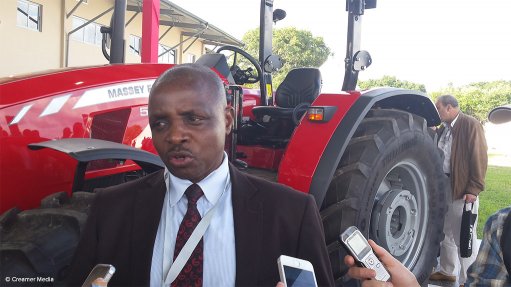
Zambia Deputy Agriculture and Livestock Minister Maxas Ng'onga
Photo by: Tracy Hancock
Copper, a significant economic driver in Zambia, had taken the country so far but would not be able to take it any further, said Zambian Deputy Agriculture and Livestock Minister Maxas Ng’onga on Thursday at the opening of the AGCO Future Farm training centre, in Lusaka, Zambia.
As Africa’s second-largest copper producer, Zambia, which was gearing up to host the Copperbelt Mining Trade Expo and Conference next month, in Kitwe, had been hit by depressed copper prices, which were compounded by escalating operating and labour costs, and controversial taxation measures.
Zambia Chamber of Mines president Nathan Chishimba in December called for a considered approach by the Zambian government and industry to look at what measures needed to be put in place to support high growth in the mining industry and create a diversified economy.
“Working together, we have to create a high-growth, diversified economy which spreads risk and opportunities across the economy, creates more jobs and widens the tax base,” he said.
Therefore, Ng’onga explained that agriculture diversification was very high on the Zambian government’s agenda, noting that this aim could be realised through mechanisation.
He highlighted that in Zambia 1.2 t/ha was produced when planting maize by hand, a method used by 77% of farmers in Africa, while 8.5 t/ha was yielded under mechanisation, used effectively by about 4% of African farmers.
American agricultural equipment manufacturer AGCO opened its Zambian training centre for English-speaking Africa after four years of development, showcasing its global brand, Massey Ferguson, which was spearheading the company’s strategy to transform African agriculture through inclusive and sustainable mechanisation.
The training centre, based on a 148 ha farm in Chongwe that cost between $12-million and $15-million to develop, accounted for $3.6-million of that spend, AGCO Corporation director of operations Africa and the Middle East Nuradin Osman told Engineering News Online.
The centre, a first for Africa, would provide training in product sales, technical services, technology solutions, dealer systems and dealer management.
“Our model is to train the trainer,” he stated, noting that the company aimed to train about 1 000 people a year.
AGCO is targeting French-speaking Africa as the location of its second farm, which Osman explained would be 10 000 ha, with a payback period of three years.
As proceeds from the Zambian farm were donated, the payback period would be over the long term in the form of significant sales growth for Massey Ferguson in Africa, he noted.
AGCO Corporation senior VP and GM Europe, Africa and the Middle East Rob Smith said Africa needed mechanisation to make the agriculture revolution a reality.
He noted that with 600-million farmers in Africa, less than 25 000 tractors were sold in the continent last year.
“Nobody considers this sufficient mechanisation for the size of the continent . . . There’s no reason to import $24-billion worth of food into [Africa, where 60% of land is not cultivated].”
To eradicate hunger and malnutrition in the next 15 years, “we need to produce more, better with less”, Smith averred.